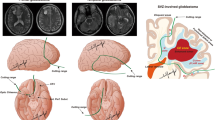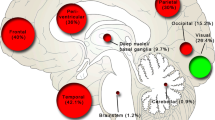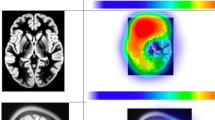Abstract
Purpose
Extent of resection remains a paramount prognostic factor for long-term outcomes for glioblastoma. As such, supramaximal resection or anatomic lobectomy have been offered for non-eloquent glioblastoma in an attempt to improve overall survival. Here, we conduct a propensity-matched analysis of patients with non-eloquent glioblastoma who underwent either lobectomy or gross total resection of lesion to investigate the efficacy of supramaximal resection of glioblastoma.
Methods
Patients who underwent initial surgery for gross total resection or lobectomy for non-eloquent glioblastoma at our tertiary care referral center from 2010 to 2019 were included for this propensity-matched survival analysis. Propensity scores were generated with the following covariates: age, location, preoperative KPS, product of perpendicular maximal tumor diameters, and product of perpendicular FLAIR signal diameters. Inverse probability of treatment weighting (IPTW) with generated propensity scores was used to compare progression-free survival and overall survival.
Results
Sixty-nine patients were identified who underwent initial resection of glioblastoma for non-eloquent glioblastoma from 2010 to 2019 (GTR = 37, lobectomy = 32). Using IPTW, overall survival (30.7 vs. 14.1 months) and progression-free survival (17.2 vs. 8.1 months were significantly higher in the lobectomy cohort compared to the GTR group (p < 0.001). There was no significant difference in pre-op or post-op KPS or complication rates between the two groups.
Conclusion
Our propensity-matched study suggests that lobectomy for non-eloquent glioblastoma confers an added survival benefit compared to GTR alone. For patients with non-eloquent glioblastoma, a supramaximal resection by means of an anatomic lobectomy should be considered as a primary surgical treatment in select patients if feasible.



Similar content being viewed by others
Availability of data and material
Not applicable.
Abbreviations
- GTR:
-
Gross total resection
- KPS:
-
Karnofsky performance status
- KM:
-
Kaplan–Meier
- OS:
-
Overall survival
- PFS:
-
Progression-free survival
- LC:
-
Local control
References
Stupp R, Mason WP, van den Bent MJ et al (2005) Radiotherapy plus concomitant and adjuvant temozolomide for glioblastoma. N Engl J Med 352(10):987–996
Millward CP, Brodbelt AR, Haylock B et al (2016) The impact of MGMT methylation and IDH-1 mutation on long-term outcome for glioblastoma treated with chemoradiotherapy. Acta Neurochir (Wien) 158(10):1943–1953
Combs SE, Rieken S, Wick W et al (2011) Prognostic significance of IDH-1 and MGMT in patients with glioblastoma: one step forward, and one step back? Radiat Oncol 6:115–115
Molenaar RJ, Verbaan D, Lamba S et al (2014) The combination of IDH1 mutations and MGMT methylation status predicts survival in glioblastoma better than either IDH1 or MGMT alone. Neuro-Oncology 16(9):1263–1273
Lacroix M, Abi-Said D, Fourney DR et al (2001) A multivariate analysis of 416 patients with glioblastoma multiforme: prognosis, extent of resection, and survival. J Neurosurg 95(2):190–198
McGirt MJ, Chaichana KL, Gathinji M et al (2009) Independent association of extent of resection with survival in patients with malignant brain astrocytoma. J Neurosurg 110(1):156–162
Lee CH, Kim DG, Kim JW et al (2013) The role of surgical resection in the management of brain metastasis: a 17-year longitudinal study. Acta Neurochir 155(3):389–397
Kye BH, Kim HJ, Kang WK, Cho HM, Hong YK, Oh ST (2012) Brain metastases from colorectal cancer: the role of surgical resection in selected patients. Colorectal Dis 14(7):e378–385
Vandenbroucke JP, von Elm E, Altman DG et al (2007) Strengthening the Reporting of Observational Studies in Epidemiology (STROBE): explanation and elaboration. Epidemiology 18(6):805–835
Wen PY, Macdonald DR, Reardon DA et al (2010) Updated response assessment criteria for high-grade gliomas: response assessment in neuro-oncology working group. J Clin Oncol 28(11):1963–1972
Roh TH, Kang SG, Moon JH et al (2019) Survival benefit of lobectomy over gross-total resection without lobectomy in cases of glioblastoma in the noneloquent area: a retrospective study. J Neurosurg. https://doi.org/10.3171/2018.12JNS182558
Wen HT, Da Roz LM, Rhoton AL Jr, Castro LH, Teixeira MJ (2017) Frontal lobe decortication (frontal lobectomy with ventricular preservation) in epilepsy-part 1: anatomic landmarks and surgical technique. World Neurosurg 98:347–364
Conner AK, Burks JD, Baker CM et al (2018) Method for temporal keyhole lobectomies in resection of low- and high-grade gliomas. J Neurosurg 128(5):1388–1395
Conner AK, Baker CM, Briggs RG et al (2017) A technique for resecting occipital pole gliomas using a keyhole lobectomy. World Neurosurg 106:707–714
Dandy W (1928) Removal of right cerebral hemisphere for certain tumors with hemiplegia. J Am Med Assoc 90:823–825
Phillippides D, Montreuil B, Steimle R (1951) Considerations on 50 glioblastomas treated by extensive excision (lobectomy). Rev Neurol (Paris) 84(5):483–485
Kelly PJ, Daumas-Duport C, Kispert DB, Kall BA, Scheithauer BW, Illig JJ (1987) Imaging-based stereotaxic serial biopsies in untreated intracranial glial neoplasms. J Neurosurg 66(6):865–874
Pia HW (1986) Microsurgery of gliomas. Acta Neurochir (Wien) 80(1–2):1–11
Hollerhage HG, Zumkeller M, Becker M, Dietz H (1991) Influence of type and extent of surgery on early results and survival time in glioblastoma multiforme. Acta Neurochir (Wien) 113(1–2):31–37
Sanai N, Polley MY, McDermott MW, Parsa AT, Berger MS (2011) An extent of resection threshold for newly diagnosed glioblastomas. J Neurosurg 115(1):3–8
Grabowski MM, Recinos PF, Nowacki AS et al (2014) Residual tumor volume versus extent of resection: predictors of survival after surgery for glioblastoma. J Neurosurg 121(5):1115–1123
Bloch O, Han SJ, Cha S et al (2012) Impact of extent of resection for recurrent glioblastoma on overall survival: clinical article. J Neurosurg 117(6):1032–1038
Li YM, Suki D, Hess K, Sawaya R (2016) The influence of maximum safe resection of glioblastoma on survival in 1229 patients: can we do better than gross-total resection? J Neurosurg 124(4):977–988
Pessina F, Navarria P, Cozzi L et al (2017) Maximize surgical resection beyond contrast-enhancing boundaries in newly diagnosed glioblastoma multiforme: is it useful and safe? A single institution retrospective experience. J Neurooncol 135(1):129–139
Duffau H (2012) Awake surgery for incidental WHO grade II gliomas involving eloquent areas. Acta Neurochir (Wien). 154(4):575–584
Yordanova YN, Moritz-Gasser S, Duffau H (2011) Awake surgery for WHO Grade II gliomas within "noneloquent" areas in the left dominant hemisphere: toward a "supratotal" resection Clinical article. J Neurosurg 115(2):232–239
Esquenazi Y, Friedman E, Liu Z, Zhu JJ, Hsu S, Tandon N (2017) The survival advantage of "supratotal" resection of glioblastoma using selective cortical mapping and the subpial technique. Neurosurgery 81(2):275–288
Duffau H (2014) Is supratotal resection of glioblastoma in noneloquent areas possible? World Neurosurg 82(1–2):e101–103
Altieri R, Melcarne A, Soffietti R et al (2019) Supratotal resection of glioblastoma: is less more? Surg Technol Int 35:432–440
Schneider M, Potthoff AL, Keil VC et al (2019) Surgery for temporal glioblastoma: lobectomy outranks oncosurgical-based gross-total resection. J Neurooncol 145(1):143–150
Molinaro AM, Hervey-Jumper S, Morshed RA et al (2020) Association of maximal extent of resection of contrast-enhanced and non-contrast-enhanced tumor with survival within molecular subgroups of patients with newly diagnosed glioblastoma. JAMA Oncology 6(4):495–503
Tamimi AF, Juweid M (2017) Epidemiology and outcome of glioblastoma. In: De Vleeschouwer S (ed) Glioblastoma. AU, Brisbane
Eichberg DG, Di L, Shah AH et al (2019) brain tumor surgery is safe in octogenarians and nonagenarians: a single-surgeon 741 patient series. World Neurosurg 132:e185–e192
Funding
National Institute of Neurological Disorders and Stroke (Grant No. R25NS108937-01). Supported by grants from the American Cancer Society (M.I.d.l.F.) and the Sylvester Comprehensive Cancer Center (M.I.d.l.F.).
Author information
Authors and Affiliations
Corresponding author
Ethics declarations
Conflict of interest
Dr. Ivan reports being a consultant to and receiving research funding from Medtronic and the NX Development Corporation.
Additional information
Publisher's Note
Springer Nature remains neutral with regard to jurisdictional claims in published maps and institutional affiliations.
Rights and permissions
About this article
Cite this article
Shah, A.H., Mahavadi, A., Di, L. et al. Survival benefit of lobectomy for glioblastoma: moving towards radical supramaximal resection. J Neurooncol 148, 501–508 (2020). https://doi.org/10.1007/s11060-020-03541-5
Received:
Accepted:
Published:
Issue Date:
DOI: https://doi.org/10.1007/s11060-020-03541-5




